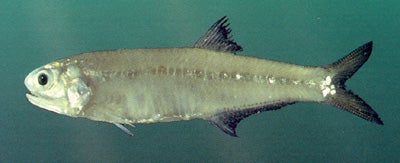SCIENTIFIC NAME:
Anchoa mitchilli
Characteristics:
On this small fish, the dorsal fin origin is located directly above the anal fin origin. It contains 12 to 14 rays, and the anal fin has 24 to 27 rays. The snout is short—about the same length as the eye. On the large mouth, the upper jaw extends backward almost to the gill opening, and the lower jaw is slightly included in the upper jaw. The body is covered with small, deciduous, easily shed scales. Lateral scales number 36 or 37; no lateral line is present. A small, axillary process is located at the base of each pectoral fin. A live bay anchovy is silver to greenish in color, with a distinctive silver stripe running the length of its body. See Cuvier and Valenciennes (1848) for original description.
ADULT SIZE:
2 to 3 in (51 to 76 mm)
DISTRIBUTION:
The bay anchovy is predominantly a marine species, but we have collected numerous individuals in tributaries on both sides of Mobile Bay as well as in the Alabama and lower Tombigbee rivers. Our collection of 99 individuals from the Black Warrior River (below Armisted I. Selden Dam, Greene County, 22 August 1986) is a new inland record for the species. Although freshwater spawning is unsubstantiated to date, it is highly unlikely that the individuals we collected, with an estimated life span of only one or two years, could have traveled 270 miles upstream from Mobile Bay and negotiated two locks and dams having a combined lift of 70 feet.
HABITAT AND BIOLOGY:
Bay anchovies are abundant in Alabama’s estuarine areas, where a single haul of a seine can capture several hundred individuals. In inland rivers, however, they are uncommon to rare. Most of the bay anchovies we observed in the Alabama and lower Tombigbee rivers were collected along the margins of aquatic vegetation and around tree limbs and other emergent structures with boat electrofishing gear. We also caught anchovies by seining along clean sand and gravel banks. Spawning occurs in estuaries from April into early June. Anchovies eat small copepods and isopods, and they are in turn eaten by predacious fishes and shorebirds.
ORIGINAL DESCRIPTION:
Valenciennes described the bay anchovy in 1848.
ETYMOLOGY:
Anchoa means herringlike.
Mitchilli is in honor of Dr. Samuel L. Mitchill, senator from New York and author of several papers on North American fishes.
The copyrighted information above is from Fishes of Alabama and the Mobile Basin.






